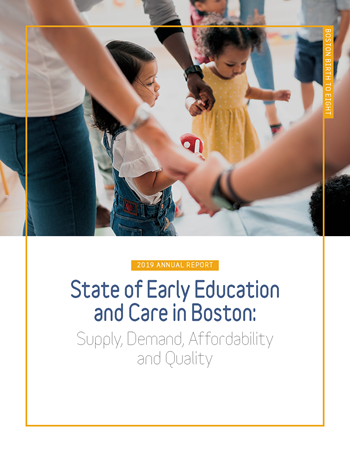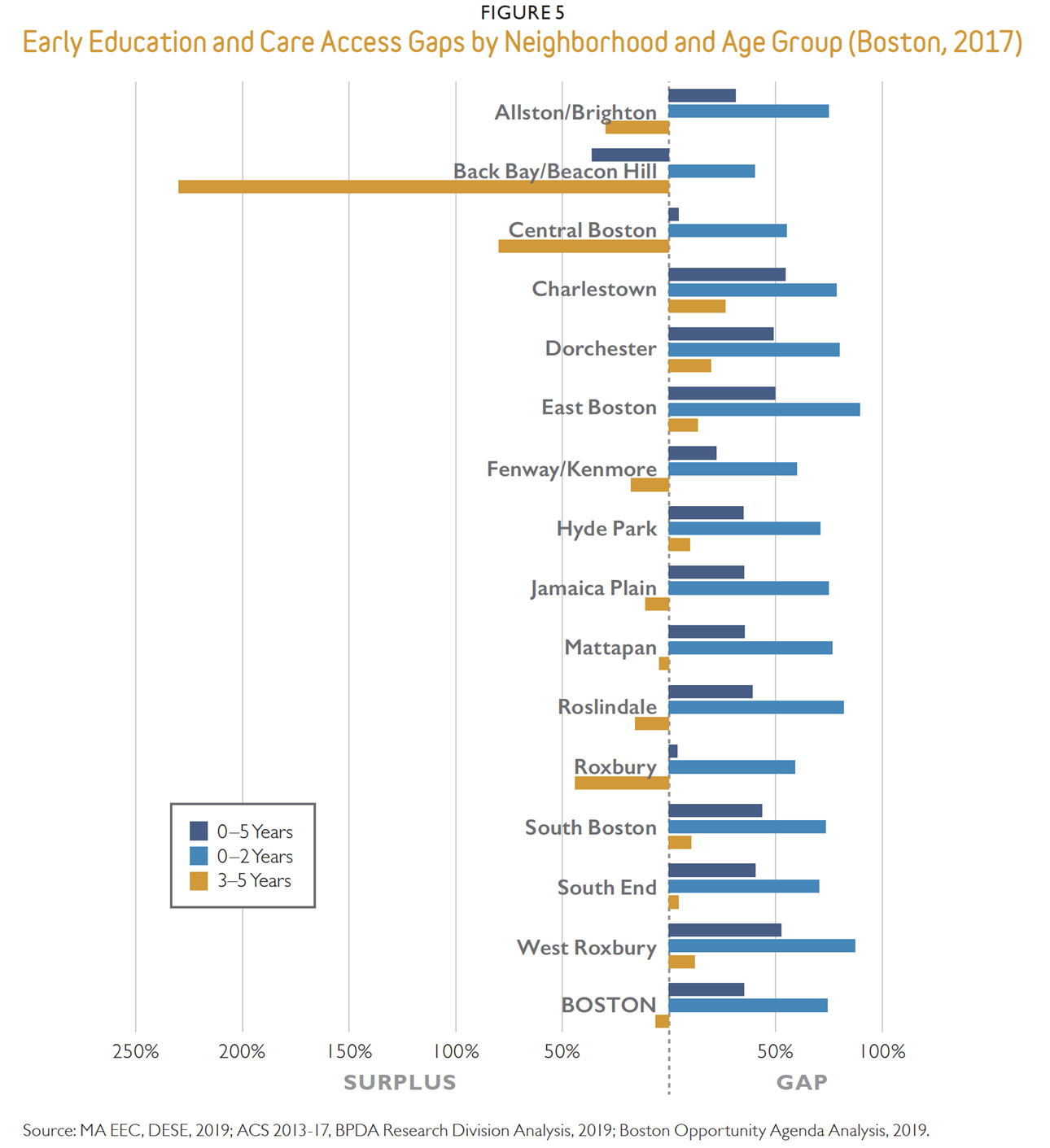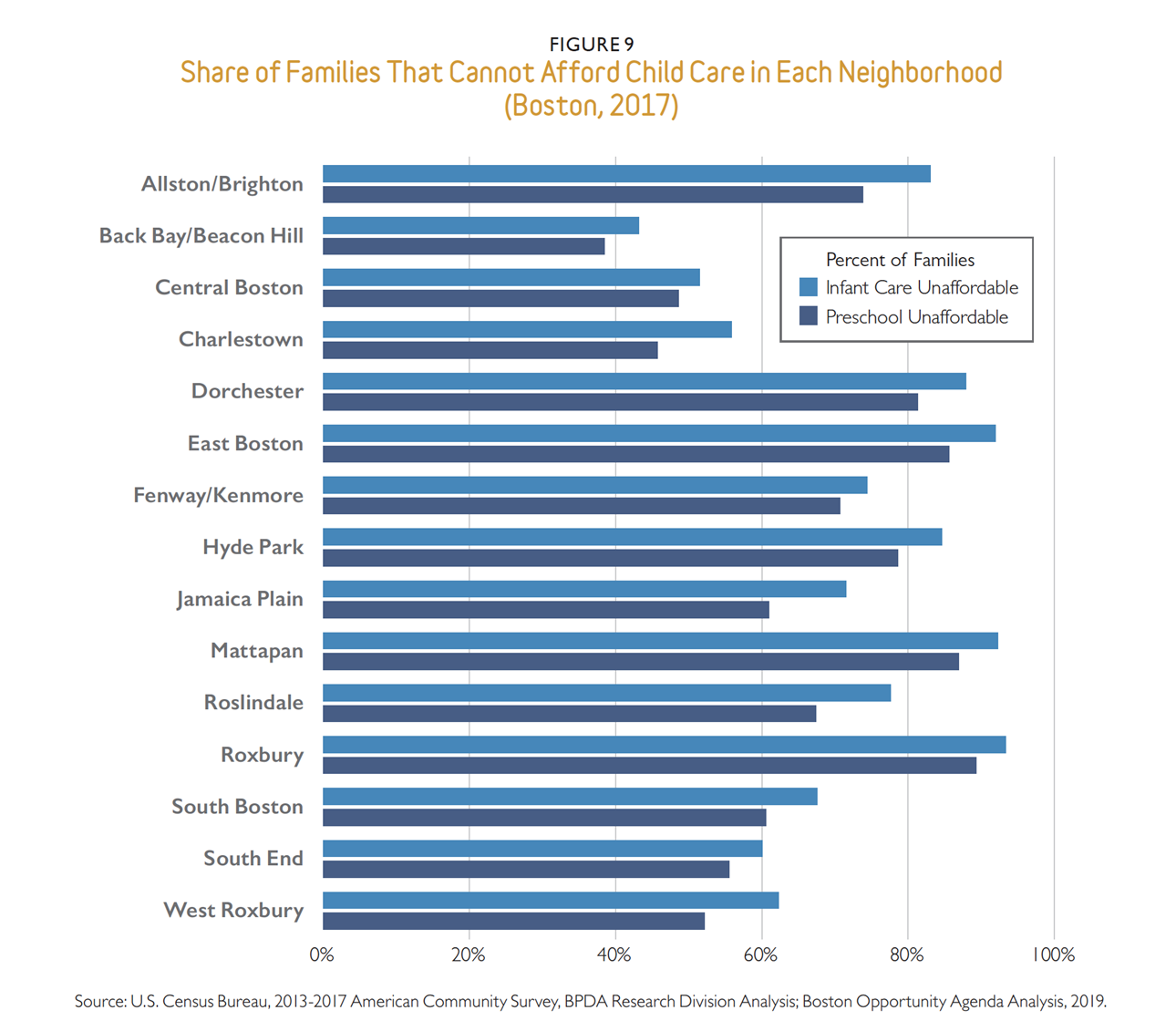Boston Opportunity Agenda early education and care census highlights citywide shortfall in availability, quality
Report notes need to improve data collection and analysis of quality care providers to improve understanding of the early education and care landscape
November 5, 2019
Boston – A new report from The Boston Opportunity Agenda confirms what parents and caregivers have sensed for years – finding quality, affordable child care for kids under age 5 is a challenge for parents across Boston.
The State of Early Education and Care in Boston: Supply, Demand, Affordability, and Quality, is the first in what is planned as an annual landscape survey of early childhood, preschool and childcare programs in every neighborhood of Boston. Compiled and written by Fernanda Q. Campbell, Ph.D., and Pratima A. Patil, Ed.M., A.M., for the Opportunity Agenda, the report estimates the gap between the potential demand for formal early education and care for children aged 0 to 5 in Boston and the number of available seats.
“Across neighborhoods, age groups and socioeconomic groups, the research suggests that Boston needs to continue its efforts to support and expand affordable high-quality child care services for young children,” said Kristin McSwain, Executive Director of the Boston Opportunity Agenda. “It also highlights the need for improved data collection and assessment of child care providers to ensure that children across social and economic groups can access quality care.”
Tracking gaps in availability, particularly for younger children
The report focuses on looking at the gap between the number of children age 0-5 in each neighborhood and the number of available child care seats. It finds that city-wide, if all children 0 to 5 sought to enroll in early programs, the city would have a 35% gap – over 14,000 seats. More than 40,000 children aged 5 and under live in the city, and the Massachusetts Dept. of Early Education and Care and Department of Elementary and Secondary Education identified just over 26,000 available seats in center-based, family-based and school-based programs.
Of those seats, the researchers identified just over 10,500 as “quality seats”, either through their scores on state assessments or their national ratings.
At the neighborhood level, only Back Bay/Beacon Hill showed a surplus of seats, though the research team notes the data can neither account for the actual percentage of parents and caregivers who seek care (often estimated at 70 to 80 percent), nor does it take into account the number of parents and caregivers from outside Boston who seek child care near their workspace in Boston, which likely skews the demand on facilities in places like Back Bay.
Splitting the 0-5 cohort in two, the researchers looked at available seats for 0-2 year-olds and 3-5 year-olds, and found while eight neighborhoods had a surplus of seats relative to their 3-5 year-old populations, every neighborhood had a gap for 0-2 year-olds, and if all children attempted to enroll, 74 percent of 0-2 year-olds would not be able to enroll. Looking at “quality seats,” as many as 54 percent of 3-5 year-olds would be unable to enroll in a “quality seat”, and 93 percent of 0-2 year-olds would be shut out of “quality seats.”
The Issue of Affordability
While inventory analysis captures some of the challenges facing parents seeking early education and care, cost is another factor – and one which keeps many parents from finding care and thus limits their economic potential. Using a federal guideline that ideally child care should not cost more than 10 percent of a family’s household income, the researchers estimate that well over half (and in Dorchester, East Boston, Hyde Park, Mattapan and Roxbury 80 percent or more) of families in the city could not afford market-rate care for even one child, a gap that available subsidies fall well short of covering.
Recommendations for possible next steps
The report concludes with a number of recommended next steps, including improvement to data collection and integration to improve the accuracy of metrics and build a citywide knowledge base to inform policy, practice and parental decision-making.
Other recommendations include scaling up investments in infrastructure and business training for existing child care centers, investing in entrepreneurs and new startups to scale the supply of child care, and incentivizing the development of high-quality care models, particularly for 0-2 year-olds.
The report also calls for ensuring higher quality care incentivizing professional development and encouraging participation in quality evaluations, and advocating for increased state and federal investments, and increased business/child-care partnerships to help bring down the cost of child care for residents and employees in the city.
--###--
The Boston Opportunity Agenda (BOA)is a public/private partnership that works to increase dramatically the pace and scale of change in education for all children in Boston, with a focus on students who experience the least access to successful pathways. Our vision: All of Boston’s children and youth are prepared to succeed in college, career and life. We fervently believe that by combining our resources, expertise and influence around a single agenda, we will have a greater impact on Boston’s cradle-to-career educational pipeline.
The partnership is entering its ninth year and is governed by the CEOs of each member organization. Together they identify strategic issues facing our education pipeline in whole or in part, formulate the Boston Opportunity Agenda priorities and strategies, and provide a call to action for community stakeholders.



